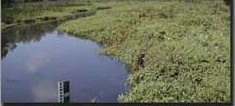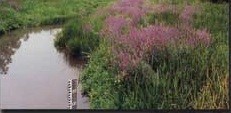Loosestrife
The purple loosestrife, a wetland plant, was imported to North America from Europe. Since its introduction, the loosestrife has spread to many wetland ecosystems in the United States.
Picture #1: Before the introduction of purple loosestrife

Picture #2: After the introduction of purple loosestrife

Photos courtesy of USDA Forest Service
Observations by scientists
Note: The numerical scores indicated in the scoring rubrics were for research purposes. Higher scores indicate higher quality argumentation. We encourage you to use a scoring scheme that matches your present goals for students.
1 Which is an example of an herbivore in this ecosystem?
- winged loosestrife
- purple loosestrife
- insect
- snake
| Level | Description | Student Responses |
|---|---|---|
| 1 |
Student selects “C”. |
|
| 0 |
Student does not select “C”. |
|
2 Why do you think the purple loosestrife is such a successful invader in this ecosystem?
I think the purple loosestrife is a good invader because ….
| Level | Description | Student Responses |
|---|---|---|
| 4 |
States a claim that provides an explanation for why the loosestrife thrives.
|
TODO Anything here?
|
| 3 |
States a claim that provides an explanation for why the loosestrife thrives.
|
I think the loosestrife is able to establish itself easily because it does not have as many species eating its leaves as the Winged loosestrife so it has the advantage to produce more of its species, which is why the Purple loosestrife quickly occupies a lot of space in a ecosystem. it has less species of insects that eat it |
| 2 |
TODO Descriptions for levels 3 and 4 are identical, there isn't one for 2, and 1 lacks criteria
|
|
| 1 |
Other valid claim:
|
|
| 0 |
Does not state a claim that explains why the loosestrife thrives No credit for: -The insects and birds like it/recognize it |
3 Why do you think the purple loosestrife is such a successful invader in this ecosystem?
My evidence is ….
| Level | Description | Student Responses |
|---|---|---|
| 1 |
Identifies a piece of data from the prompt or from prior knowledge References evidence from prompt. If student references evidence from prior knowledge, then check to see that it relates to claim. Common responses given credit:
|
the pictures that show the water and the plants observation #1 because based on observation #2, the purple loosestrife has less insect species predators, and more predators that can help populate the species (birds) |
| 0 |
Does not identify a piece of evidence from prompt or prior knowledge. |
thinking about trees, you have trees everywhere |
4 Why do you think the purple loosestrife is such a successful invader in this ecosystem?
This evidence supports my claim because ….
| Level | Description | Student Responses |
|---|---|---|
| 1 |
Provides reasoning that connects the claim and evidence |
With less useless predators, the species can grow more, and with birds they are able to move around more too since there are less species of animals eating the purple loosestrife, the plant is able to grow more quickly that the winged loosestrife |
| 0 |
The claim is about why the loosestrife is successful, so it is not sufficient to just explain what the evidence shows. Student need connect claim to evidence—e.g. “if the plant is from a wetland, and it is placed in a wetland, then it will be successful because it is adapted to a wetland environment” No credit for illogical reasoning. |
It tells us that the purple loosestrife is a wetland plant As the plant grows at a faster rate, this expresses the adaptation that it acquired in order to be able to survive the changes within an environment. This demonstrates that the species was able to interact with other biotic factors within the ecosystem as well |
Only 5 different species eat the purple loosestrife.
Since it was so few things that eat it, it can just keep growing and it can take over the ecosystem.
The purple loosestrife grows twice as fast as a native plant.
If the purple loosestrife grows faster than other species, then it can compete better for light, nutrients, and space.
5 Which argument do you agree with more?
Sophie's or Tina's
*Student does not provide explicit two-sided comparative argument, but must engage in that cognitive task to select the stronger argument
| Level | Description | Student Responses |
|---|---|---|
| 1 |
Tina: grows faster |
|
| 0 |
Sophie: fewer herbivores |
|
6 Why do you agree with this argument more?
I agree with this argument more because ….
| Level | Description | Student Responses |
|---|---|---|
| 3 |
Defends one position (explaining how there is more evidence, better evidence, better connection between claim and evidence, or a more scientifically accurate claim based on students’ prior knowledge) |
Student defends Sophie:
evidence from observation #2. Although Tina's arguement is valid, Sophie's is stronger because she has quantitive data, and qualitative data Argues for superiority of evidence for Sophie
|
| 2 |
Note: This level of performance corresponds to argumentation level 2a: Providing a counter-critique
Critiques the other argument. |
Student defends Tina:
Although that there are only five different species that eat the purple loosestrife, it does not mean that only a few insects feed off of it. There can be hundreds of the same species. I agree more with Tina's argument because it makes more sense and provides accurate and specific information Critiques Sophie.
|
| 1 |
Defends argument by saying it aligns with students’ claim. Essentially, “this argument is better because it is closer to mine” |
|
| 0 |
Does not defend one position or critique another. |
7 Why do you think the other argument is not as good?
The problem with the other argument is ….
| Level | Description | Student Responses |
|---|---|---|
| 2 |
Provides counter-critique e.g. Fewer species, but not necessarily fewer organisms predating on purple loosestrife |
Student critiques of Sophie:
Sophie's argument does not state how many organisms are in each specie. Therefore even if there are less species that eat the plant, there is no evidence about whether or not the amount of organisms that eat it Student critiques of Sophie:
it doesn't necessarily matter how many species of organisms eat something, but rather how many of those organisms there are Student critiques of Sophie:
The problem with the other argument is that they state that there are only five species. However, there can be hundreds of insects from one species feeding off the tree. The five species does not necessarily mean that there are a few insects that eat it. |
| 1 |
Note: This level of performance corresponds to Argumentation Level 1d: Providing an alternative counter argument
Provides counter-alternative Basically, “this argument is wrong because the other argument is right” |
The problem with the other argument is that growth rate is really the one that is more important. |
| 0 |
Does not provide counter-critique or counter-alternative No credit for general critiques, e.g. “not enough evidence” or “better reasoning” No credit for “doesn’t take into account the other idea” |
The problem with the other argument is that it is not as good. |





